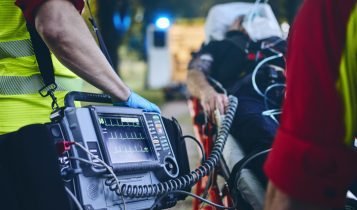How to become a Paramedic is one of the most trending medical career search of this present age and dispensation.
Keep in mind that choosing a career in the health care industry is a good choice both in terms of job availability and job stability.
You should consider becoming a paramedic if you desire a job in the medical field but you are not interested in becoming a nurse or doctor.
This is indeed a plausible choice for people in your position.
This article will provide an understanding of the duties and responsibilities of a paramedic as well as the actions that need to be taken to become a paramedic.
Key Takeaways
- A Paramedic is a medical professional who specializes in emergency treatment.
- Paramedics frequently work in pairs, with one driving the ambulance and the other caring for the patient.
- Not every ambulance personnel is a paramedic.
- A paramedic’s job prospects are not limited to working in a hospital setting.
- Paramedics provide more thorough pre-hospital care than EMTs.
Who is this Paramedic Article for?
If you are on the verge of discovering your full potential in the medical science and you’ve found yourself asking questions about how to become a Paramedic along the way.
Then this article is for you, we’ve take so much time and resources to put this publication on how to become a paramedic;
So that it can provide you with the necessary answers to all your Questions concerning becoming a Paramedic.
Therefore, this article will cut across various sections of the Paramedic science such as;
- What is exactly is a paramedic?
- What does Paramedics do?
- What are the Basic Skills required to become a Paramedic?
- How much does a Paramedic Earn?
- The Entry Requirements to Become a Paramedic.
- How long does it take to become a Paramedic?
- What are the Paramedic Trainings and Certifications one can achieve?
- and Much more!
First and foremost,
What is a paramedic?
 A paramedic is a licensed health care worker who offers emergency medical care to individuals who are severely ill or injured.
A paramedic is a licensed health care worker who offers emergency medical care to individuals who are severely ill or injured.
They are often the health care experts who arrive first to an accident or emergency and stabilize a patient for safe transport to a nearby hospital or clinic as performing their duties as first responders.
As a result, paramedics frequently work in pairs, with one driving the ambulance and the other caring for the patient throughout transport.
The team could include two paramedics or one paramedic and one emergency medical technician (EMT).
Who is a Paramedic?
A paramedic is a person who works in the health care business and whose major role is to provide advanced medical care in an emergency environment to patients who have access to the emergency medical system.
A paramedic is a medical professional who specializes in emergency treatment.
Not every ambulance personnel is a paramedic. In English-speaking countries, a formal distinction is made between emergency medical technicians (or emergency care assistants) and paramedics.
Paramedics must complete higher educational requirements and have a greater scope of practice compared to an emergency medical technician.
Paramedical personnel are essential component of the healthcare industry and are tasked with the responsibility of giving the patient with initial care in the event of an emergency.
The human body is home to a wide variety of ailments, and paramedics are trained medical experts who are able to identify these disorders and lend their support to doctors by doing medical examinations and other forms of therapy to guarantee that patients receive the best possible care.
The majority of paramedics’ time is spent on the road, responding to emergency calls or transferring patients.
They may work on airplanes and helicopters in addition to ambulances.
A paramedic’s job prospects are not limited to working in a hospital setting alone.
They can work as firefighter paramedics or for rescue organizations like ocean rescue.
Paramedics are also required for children’s camp programs and private ambulance services and much more.
So,
Must Read: Top 10 Paramedical Courses You Should Consider
What does a Paramedic Do?
Paramedics operate in medical emergency response teams.
They function under the supervision of a doctor, who is most often times, not present.
They may contact a doctor by phone, radio, or pre-written orders.
Paramedics also make decisions about patient care and oversee team members with less training(such as EMTs).
In general, paramedics provide more thorough pre-hospital care than EMTs.
In addition to performing EMT operations, paramedics can administer drugs orally and intravenously, interpret electrocardiograms (EKGs);
Which are used to monitor heart function, and they also make use of other monitors and complicated equipment.
Popular Article: Top 20 Fastest Growing Nursing Careers You Should Consider
What does a Paramedic Do on a Daily Basis?
 A paramedic’s usual day-to-day responsibilities include;
A paramedic’s usual day-to-day responsibilities include;
- Providing medical assistance to patients and occasionally driving ambulances and other emergency vehicles.
- Performing patient evaluations, making clinical diagnoses, and administering emergency treatment.
- Providing pain and intravenous infusions, among other medical treatments.
- Assisting mothers give birth to their babies.
- Keeping patient care records up to date and submitting relevant reports for each emergency response.
- Utilizing specialized equipment, such as ventilators and defibrillators, throughout the therapy process.
- Performing regular upkeep on all of the machinery and ensuring that it is in good functioning condition.
- Maintaining a hygienic condition in ambulances or other worksites and refilling devices and supplies.
- Perform CPR (Cardiopulmonary resuscitation).
- Administer IV medications.
- and more!
See Also: Comprehensive List of Everything a Paramedic Does?
Paramedic Skills That You Must Have
Becoming a Paramedic requires that you must possess certain skills and characteristics as both an individual or as a professional.
Below are essential Skills required to become a Paramedic:
- Excellent Teamwork.
- Incredible linguistic and interpersonal communication abilities.
- Compassion and sensitivity for the wellbeing of people.
- The capacity to make swift judgments and maintain composure under intense pressure.
- A Paramedic should have a healthy level of physical fitness.
- Driving and navigational skills.
- Resilience.
- Physical Stamina.
- Mental toughness and More
Relevant Insight: Full List of Essential Skills You Must Have as a Paramedic (With Explanations)
How to Become a Paramedic
If you want to work as a paramedic, you will need to establish a number of qualifications first.
The following is a step-by-step procedure that you should follow to ensure that you have all of the necessary qualifications in place:
1. Obtain a high school diploma or your GED
To begin your road toward a career as a paramedic, you will first need to get your high school diploma or a General Equivalency Diploma (GED).
The accomplishment of relevant courses, in anatomy and physiology, can equip you with useful basic knowledge necessary for a job as a paramedic.
In addition to having completed high school, you need to be at least 18 years old before you may begin your journey of becoming a Paramedic.
This requirement is put in place to protect the community.
2. Obtain a certification for EMT-Basic level training.
You will also have to first acquire your certification as an EMT-Basic, which is the entry-level position in the EMT career ladder, before you can move on to the next level of training;
Which is paramedic school.
On average, it takes around six months to finish the training required to become an EMT-Basic.
The training consists of learning how to take vital signs and how to provide basic life support, such as giving oxygen or performing cardiopulmonary resuscitation (CPR).
Applicants undergo training in a diverse array of non-invasive procedures and skills as well.
Controlling bleeding, treating burns, splinting suspected fractures and spinal injuries, and administering a select group of drugs are some of these procedures.
You will be able to sit for the certification exam offered by the National Registry of Emergency Medical Technicians (NREMT) as soon as you have finished all of the requirements necessary to become an EMT-Basic.
3. Obtain prior work experience.
To be eligible to a paramedic training program, you may be required to have a minimum of six months to a year of previous work experience as an EMT.
This requirement differs from program to program.
Getting practical experience on the job can assist in equipping you with a good start for your paramedic training, even if it isn’t a necessity.
If should try to get some work experience.
4. Successfully complete a training program to become a paramedic.
There is a broad set of paramedic training programs available, and completion of one of these programs can lead to the awarding of a certificate, diploma, or associate degree.
Candidates for the position of paramedics emerge from their training with advanced capabilities in the areas of cardiology, trauma treatment, patient assessment, drug administration, airway techniques, and patient stabilization.
Majority of the time, students in these programs will also participate in field clinical rotations and ambulance shifts.
You should also anticipate to finish your training within one to two years, however this may depend on the curriculum you choose.
5. Obtain your certification and license to practice as a paramedic.
In every state, being licensed as a paramedic is a must for working in the field.
In order to become eligible for a license, you must first earn your national certification by taking and successfully completing the appropriate NREMT examination, which includes both a cognitive and a psychomotor exam.
The latter component assesses the candidate’s ability to evaluate patients in a variety of subfields, including trauma, dynamic cardiology, and an integrated out-of-hospital training scenario.
Before you are allowed to work as a licensed paramedic in a particular state, you might also be required to pass an examination that is unique to that state if that state is where you intend to practice as a paramedic.
Incase you missed it: Here are the Admission Requirements in order to Study Paramedical Courses
How long does it take to become a Paramedic

The actual training to become a paramedic takes anywhere from 18 to 24 months, depending on the curriculum.
This observation is made by taking into account the possibility of passing all your tests and exams on your first trial.
Having said that, there is a great deal more to it.
First, you have to complete the EMT-B training, which can take anywhere from four to six months to complete.
After that, the next most critical step is you gaining proficiency in Basic Life Support abilities by working as an EMT for as long as it takes to reach a level of competence.
This can be completed faster in a career service area that receives a high volume of calls as compared to volunteer services that receives fewer calls.
Remember that experience is a critical component not only to your own achievement but also to the patient’s chances of surviving an incident.
After these, You must now focus on being accepted into the paramedic program.
This will come with a prerequisite for an A&P course at the 200-level, and it will be required to include a lab credit.
The next step is the placement test, which is quite similar to the admissions examination for the institution.
After that, you will need to retake the EMT-B exam and achieve a score of at least 85 percent on it.
In order to graduate from some colleges, you are required to retake the EMT-B practical exam and achieve a score of one hundred percent at each station, with no deficiencies of any type.
Author’s Recommendation: Complete List of Top Best Paramedical Courses (Eligibility, Careers, Salary)
Continue Reading…
How do you become a paramedic?

During these times of becoming a Paramedic, you will be under constant and intensive observation while you study and practice the various psychomotor skills that are expected of a paramedic (most of which is done in the hospital or on board ambulances on real life patients).
Let’s say that you succeed in all of your theoretical classes, all of your practical classes, and your capstone.
Now you must pass the practical exam for the paramedic, which consists of 12 stations.
Two of these stations are oral boards, during which you will be required to talk your way through a complicated ALS call without making any mistakes.
If you are successful on the first attempt at all 12 questions, then you will move on to the written portion of the exam.
The traditional paper test consists of 200 questions, and you have approximately 90 minutes to complete it.
In order to pass, you will need an 80 percent score.
When you are successful, you will now be in possession of your NREMT-Paramedic card.
Since 2010, Pearson Vue has been in charge of administering that test, and candidates now have to answer questions using a computer.
Because this is an open-ended test, the computer will ask you a variety of questions and evaluate your performance based on an algorithm that determines whether or not you passed the test.
You just need to fill out some paperwork, and you’ll soon have a license to practice as a paramedic in that state.
In all seriousness, there is something that you need to look into BEFORE you begin any of the aforementioned steps.
A conviction for driving while intoxicated or domestic violence that occurred five years ago could be a deal breaker, depending on the state or county in which you live or may want to work in.
Your state will look into your background and determine whether you should be left alone with helpless unconscious people or not.
At last, You are now a paramedic if you have completed ALL of these requirements.
Popular opinion: Should I become a Paramedic? See Paramedical Personnel’s Advise
What is the workplace of a Paramedic like?

EMTs and paramedics work both indoors and outdoors in all weather conditions.
Their work is physically demanding and stressful, at times involving life-or-death situations and suffering patients.
The majority of career EMTs and paramedics work in urban areas.
Volunteer EMTs and paramedics are more prevalent in small towns, cities, and rural areas.
These individuals volunteer for fire departments, emergency medical service providers, or hospitals and may only answer to a few calls per month.
In an emergency, paramedics and EMTs must provide emotional support to patients, particularly those in life-threatening conditions or acute mental suffering.
They virtually often work in groups and must be able to closely coordinate their actions with others in high-stress situations.
They always have to listen to patients in order to establish the severity of their injuries or illnesses.
Paramedics must also be physically fit.
Their job requires a great deal of bending, lifting, and kneeling.
Trending article: How to Cure Pimples with 5 Effective Home Remedies
What are the differences between a paramedic and an emergency medical technician (EMT)?
Paramedics are the most experienced and well-trained EMTs.
To become an EMT-Basic, the NREMT requires 120-150 hours of training, which can take up to six months to accomplish.
This is far less than the 1,200-1,800 hours of training, over two years, required to take the EMT-Paramedic certification exam.
Paramedics undertake more intense procedures and a larger range of therapies on patients in emergency situations, such as using ventilators and IVs, thanks to their enhanced training.
EMTs provide basic care, such as bandaging wounds and assisting with patient transfer.
In comparison to basic EMTs, paramedics can work in more complex emergency scenarios.
For a comprehensive knowledge of the differences between a Paramedic and an Emergency Medical Technician, see our below article.
Must Read: Differences between a paramedic and an emergency medical technician (EMT).
Quick Recap on how to become a Paramedic
Providing emergency medical care necessitates a well-trained, laser-focused expert with the ability to make sound decisions rapidly.
With the right training, successful paramedics are capable of providing high-quality medical attention in challenging situations.
Understanding the paramedic job description will assist you in making an educated decision about whether or not this is the right career path for your aspirations.
How long does it take to become an EMT or paramedic? What are the distinctions between paramedics and paramedics? These are some of the questions we answered in this article.
Let’s hear from you, what are your opinions, suggestions or contributions.
Kindly make use of the comment box below this article, we can’t wait for your feedback.
Also feel free to share this article with loved ones and family, Remember that Sharing is Caring!
See What Others Are Reading:
- Get a Canadian Student Visa in 5 Easy Steps!
- 15 Highest Paying 2 Year Degree Jobs In the World.
- Top 20 Fastest Growing Nursing Careers You Should Consider
Didn't find what you were looking for? Search here


